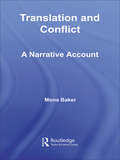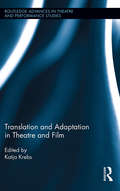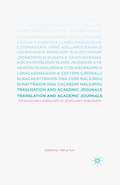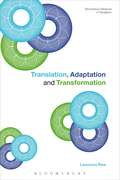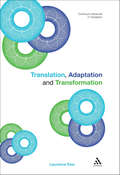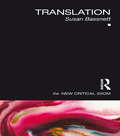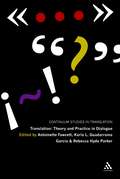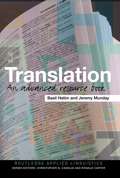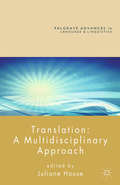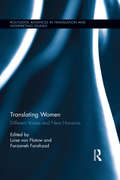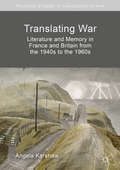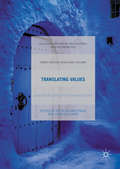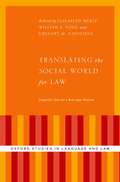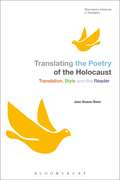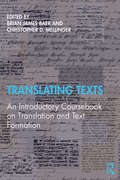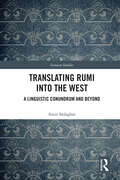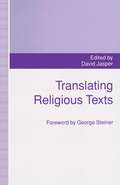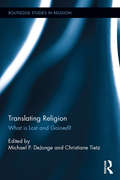- Table View
- List View
Translation and Conflict: A Narrative Account
by Mona BakerTranslation and Conflict demonstrates that translators and interpreters participate in circulating as well as resisting the narratives that create the intellectual and moral environment for violent conflict. Drawing on narrative theory and using numerous examples from historical and contemporary conflicts, the author provides an original and coherent model of analysis that pays equal attention to micro and macro aspects of the circulation of narratives in translation, to translation and interpreting, and to questions of dominance and resistance. The study is particularly significant at this juncture of history, with the increased interest in the positioning of translators in politically sensitive contexts, the growing concern with translators’ and interpreters’ divided loyalties in settings such as Guantanamo, Iraq, Kosovo, and other arenas of conflict, and the emergence of several activist communities of translators and interpreters with highly politicized agendas of their own, including Babels, Translators for Peace, Tlaxcala and ECOS. Including further reading suggestions at the end of each chapter, Translation and Conflict will be of interest to students of translation, intercultural studies and sociology as well as the reader interested in the study of social and political movements.
Translation and Adaptation in Theatre and Film (Routledge Advances in Theatre & Performance Studies)
by Katja KrebsThis book provides a pioneering and provocative exploration of the rich synergies between adaptation studies and translation studies and is the first genuine attempt to discuss the rather loose usage of the concepts of translation and adaptation in terms of theatre and film. At the heart of this collection is the proposition that translation studies and adaptation studies have much to offer each other in practical and theoretical terms and can no longer exist independently from one another. As a result, it generates productive ideas within the contact zone between these two fields of study, both through new theoretical paradigms and detailed case studies. Such closely intertwined areas as translation and adaptation need to encounter each other’s methodologies and perspectives in order to develop ever more rigorous approaches to the study of adaptation and translation phenomena, challenging current assumptions and prejudices in terms of both. The book includes contributions as diverse yet interrelated as Bakhtin’s notion of translation and adaptation, Bollywood adaptations of Shakespeare’s Othello, and an analysis of performance practice, itself arguably an adaptive practice, which uses a variety of languages from English and Greek to British and International Sign-Language. As translation and adaptation practices are an integral part of global cultural and political activities and agendas, it is ever more important to study such occurrences of rewriting and reshaping. By exploring and investigating interdisciplinary and cross-cultural perspectives and approaches, this volume investigates the impact such occurrences of rewriting have on the constructions and experiences of cultures while at the same time developing a rigorous methodological framework which will form the basis of future scholarship on performance and film, translation and adaptation.
Translation and Adaptation in Theatre and Film (Routledge Advances in Theatre & Performance Studies)
by Katja KrebsThis book provides a pioneering and provocative exploration of the rich synergies between adaptation studies and translation studies and is the first genuine attempt to discuss the rather loose usage of the concepts of translation and adaptation in terms of theatre and film. At the heart of this collection is the proposition that translation studies and adaptation studies have much to offer each other in practical and theoretical terms and can no longer exist independently from one another. As a result, it generates productive ideas within the contact zone between these two fields of study, both through new theoretical paradigms and detailed case studies. Such closely intertwined areas as translation and adaptation need to encounter each other’s methodologies and perspectives in order to develop ever more rigorous approaches to the study of adaptation and translation phenomena, challenging current assumptions and prejudices in terms of both. The book includes contributions as diverse yet interrelated as Bakhtin’s notion of translation and adaptation, Bollywood adaptations of Shakespeare’s Othello, and an analysis of performance practice, itself arguably an adaptive practice, which uses a variety of languages from English and Greek to British and International Sign-Language. As translation and adaptation practices are an integral part of global cultural and political activities and agendas, it is ever more important to study such occurrences of rewriting and reshaping. By exploring and investigating interdisciplinary and cross-cultural perspectives and approaches, this volume investigates the impact such occurrences of rewriting have on the constructions and experiences of cultures while at the same time developing a rigorous methodological framework which will form the basis of future scholarship on performance and film, translation and adaptation.
Translation and Academic Journals: The Evolving Landscape of Scholarly Publishing
by Yifeng SunThis volume comes at a time of rapid expansion in the discipline of Translation Studies and the growth of related journals. Experts and editors of leading journals in the field probe the interactive relationship between the production of journals and the development of Translation Studies and provide a contextual framework for evaluating the field.
Translation, Adaptation and Transformation (Continuum Advances in Translation)
by Laurence RawIn recent years adaptation studies has established itself as a discipline in its own right, separate from translation studies. The bulk of its activity to date has been restricted to literature and film departments, focussing on questions of textual transfer and adaptation of text to film. It is however, much more interdisciplinary, and is not simply a case of transferring content from one medium to another. This collection furthers the research into exactly what the act of adaptation involves and whether it differs from other acts of textual rewriting. In addition, the 'cultural turn' in translation studies has prompted many scholars to consider adaptation as a form of inter-semiotic translation. But what does this mean, and how can we best theorize it? What are the semiotic systems that underlie translation and adaptation? Containing theoretical chapters and personal accounts of actual adaptions and translations, this is an original contribution to translation and adaptation studies which will appeal to researchers and graduate students.
Translation, Adaptation and Transformation (Continuum Advances in Translation #8)
by Laurence RawIn recent years adaptation studies has established itself as a discipline in its own right, separate from translation studies. The bulk of its activity to date has been restricted to literature and film departments, focussing on questions of textual transfer and adaptation of text to film. It is however, much more interdisciplinary, and is not simply a case of transferring content from one medium to another. This collection furthers the research into exactly what the act of adaptation involves and whether it differs from other acts of textual rewriting. In addition, the 'cultural turn' in translation studies has prompted many scholars to consider adaptation as a form of inter-semiotic translation. But what does this mean, and how can we best theorize it? What are the semiotic systems that underlie translation and adaptation? Containing theoretical chapters and personal accounts of actual adaptions and translations, this is an original contribution to translation and adaptation studies which will appeal to researchers and graduate students.
Translation (The New Critical Idiom)
by Susan BassnettIn a time when millions travel around the planet; some by choice, some driven by economic or political exile, translation of the written and spoken word is of ever increasing importance. This guide presents readers with an accessible and engaging introduction to the valuable position translation holds within literature and society. Leading translation theorist, Susan Bassnett traces the history of translation, examining the ways translation is currently utilised as a burgeoning interdisciplinary activity and considers more recent research into developing technologies and new media forms. Translation displays the importance of translation across disciplines, and is essential reading for students and scholars of translation, literary studies, globalisation studies, and ancient and modern languages.
Translation (The New Critical Idiom)
by Susan BassnettIn a time when millions travel around the planet; some by choice, some driven by economic or political exile, translation of the written and spoken word is of ever increasing importance. This guide presents readers with an accessible and engaging introduction to the valuable position translation holds within literature and society. Leading translation theorist, Susan Bassnett traces the history of translation, examining the ways translation is currently utilised as a burgeoning interdisciplinary activity and considers more recent research into developing technologies and new media forms. Translation displays the importance of translation across disciplines, and is essential reading for students and scholars of translation, literary studies, globalisation studies, and ancient and modern languages.
Translation: Translation: Theory And Practice In Dialogue (Continuum Studies in Translation)
by Antoinette Fawcett Karla L. Guadarrama García Rebecca Hyde ParkerThis exciting new book explores the present relevance of translation theory to practice. A range of perspectives provides both current theoretical insights into the relevance of theory to translation and also offers first-hand experiences of applying appropriate strategies and methods to the practice and description of translation. The individual chapters in the book explore theoretical pronouncements and practical observations grouped in topics that include theory and creativity, translation and its relation with linguistics, gender issues and more. The book features four parts: it firstly deals with how theories from both within translation studies and from other disciplines can contribute to our understanding of the practice of translation; secondly, how theory can be reconceptualized from examining translation in practice; thirdly reconceptualizing practice from theory; and finally Eastern European and Asian perspectives of how translation theory and practice inform one another. The chapters all show examples from theoretical and practical as well as pedagogical issues ensuring appeal for a wide readership. This book will appeal to advanced level students, researchers and academics in translation studies.
Translation: An Advanced Resource Book (PDF)
by Basil Hatim Jeremy MundayRoutledge Applied Linguistics is a series of comprehensive textbooks, providing students and researchers with the support they need for advanced study in the core areas of English language and Applied Linguistics. Each book in the series guides readers through three main sections, enabling them to explore and develop major themes within the discipline. Section A, Introduction, establishes the key terms and concepts and extends readers’ techniques of analysis through practical application. Section B, Extension, brings together influential articles, sets them in context, and discusses their contribution to the field. Section C, Exploration, builds on knowledge gained in the first two sections, setting thoughtful tasks around further illustrative material. This enables readers to engage more actively with the subject matter and encourages them to develop their own research responses. Throughout the book, topics are revisited, extended, interwoven and deconstructed, with the reader’s understanding strengthened by tasks and follow-up questions. Translation: examines the theory and practice of translation from a variety of linguistic and cultural angles, including semantics, functional linguistics, corpus and cognitive linguistics, discourse analysis, gender studies and postcolonialism draws on a wide range of languages, including French, Spanish, German, Italian, Russian and Arabic explores material from a variety of sources, such as the Internet, advertisements, religious texts, literary and technical texts gathers together influential readings from the key names in the discipline, including James S. Holmes, George Steiner, Vinay and Darbelnet, Eugene Nida, Werner Koller and Ernst-August Gutt. Written by experienced teachers and researchers in the field, Translation: An Advanced Resource Book is an essential textbook for students and researchers of English language and Applied Linguistics. The accompanying website to this book can be found at http://www.routledge.com/textbooks/041528306X
Translation: A Multidisciplinary Approach (Palgrave Advances in Language and Linguistics)
by Juliane HouseThe cross-linguistic and cross-cultural practice of translation is a field of rapidly growing international importance. World-renowned experts offer new and multidisciplinary insights on this subject, viewing translation as social action and intercultural communication, and as a phenomenon of languages in contact and a socio-cognitive process.
Translating Women: Different Voices and New Horizons (Routledge Advances in Translation and Interpreting Studies)
by Luise Von Flotow Farzaneh FarahzadThis book focuses on women and translation in cultures 'across other horizons' well beyond the European or Anglo-American centres. Drawing on transnational feminist connections, its editors have assembled work from four continents and included articles from Morocco, Mexico, Sri Lanka, Turkey, China, Saudi Arabia, Columbia and beyond. Thirteen different chapters explore questions around women's roles in translation: as authors, or translators, or theoreticians. In doing so, they open new territories for studies in the area of 'gender and translation' and stimulate academic work on questions in this field around the world. The articles examine the impact of 'Western' feminism when translated to other cultures; they describe translation projects devised to import and make meaningful feminist texts from other places; they engage with the politics of publishing translations by women authors in other cultures, and the role of women translators play in developing new ideas. The diverse approaches to questions around women and translation developed in this collection speak to the volume of unexplored material that has yet to be addressed in this field.
Translating Women: Different Voices and New Horizons (Routledge Advances in Translation and Interpreting Studies)
by Luise Von Flotow Farzaneh FarahzadThis book focuses on women and translation in cultures 'across other horizons' well beyond the European or Anglo-American centres. Drawing on transnational feminist connections, its editors have assembled work from four continents and included articles from Morocco, Mexico, Sri Lanka, Turkey, China, Saudi Arabia, Columbia and beyond. Thirteen different chapters explore questions around women's roles in translation: as authors, or translators, or theoreticians. In doing so, they open new territories for studies in the area of 'gender and translation' and stimulate academic work on questions in this field around the world. The articles examine the impact of 'Western' feminism when translated to other cultures; they describe translation projects devised to import and make meaningful feminist texts from other places; they engage with the politics of publishing translations by women authors in other cultures, and the role of women translators play in developing new ideas. The diverse approaches to questions around women and translation developed in this collection speak to the volume of unexplored material that has yet to be addressed in this field.
Translating War: Literature and Memory in France and Britain from the 1940s to the 1960s (Palgrave Studies in Languages at War)
by Angela KershawThis book examines the role played by the international circulation of literature in constructing cultural memories of the Second World War. War writing has rarely been read from the point of view of translation even though war is by definition a multilingual event, and knowledge of the Second World War and the Holocaust is mediated through translated texts. Here, the author opens up this field of research through analysis of several important works of French war fiction and their English translations. The book examines the wartime publishing structures which facilitated literary exchanges across national borders, the strategies adopted by translators of war fiction, the relationships between translated war fiction and dominant national memories of the war, and questions of multilingualism in war writing. In doing so, it sheds new light on the political and ethical questions that arise when the trauma of war is represented in fiction and through translation. This engaging work will appeal to students and scholars of translation, cultural memory, war fiction and Holocaust writing.
Translating Values: Evaluative Concepts in Translation (Palgrave Studies in Translating and Interpreting)
by John Gillespie Piotr BlumczynskiThis collection explores the central importance of values and evaluative concepts in cross-cultural translational encounters. Written by a group of international scholars from a diverse range of linguistic and cultural backgrounds, the chapters in this book consider what it means to translate cultures by examining core values and their relationship to key evaluative concepts (such as authenticity, clarity, home, honour, or justice) and how they influence the complex multidimensional process of translation. This book will be of interest to academics studying cross-cultural and inter-linguistic interactions, to translators and interpreters, students of translation and of modern languages, and all those dealing with multilingual and multicultural settings.
Translating the Social World for Law: Linguistic Tools for a New Legal Realism (Oxford Studies in Language and Law)
by Elizabeth Mertz William K. Ford Gregory MatoesianThis volume examines the linguistic problems that arise in efforts to translate between law and the social sciences. We usually think of "translation" as pertaining to situations involving distinct languages such as English and Swahili. But realistically, we also know that there are many kinds of English or Swahili, so that some form of translation may still be needed even between two people who both speak English-including, for example, between English speakers who are members of different professions. Law and the social sciences certainly qualify as disciplines with quite distinctive language patterns and practices, as well as different orientations and goals. In coordinated papers that are grounded in empirical research, the volume contributors use careful linguistic analysis to understand how attempts to translate between different disciplines can misfire in systematic ways. Some contributors also point the way toward more fruitful translation practices. The contributors to this volume are members of an interdisciplinary working group on Legal Translation that met for a number of years. The group includes scholars from law, philosophy, anthropology, linguistics, political science, psychology, and religious studies. The members of this group approach interdisciplinary communication as a form of "translation" between distinct disciplinary languages (or, "registers"). Although it may seem obvious that professionals in different fields speak and think differently about the world, in fact experts in law and in social science too often assume that they can communicate easily when they are speaking what appears to be the "same" language. While such experts may intellectually understand that they differ regarding their fundamental assumptions and uses of language, they may nonetheless consistently underestimate the degree to which they are actually talking past one another. This problem takes on real-life significance when one of the fields is law, where how knowledge is conveyed can affect how justice is meted out.
Translating the Poetry of the Holocaust: Translation, Style and the Reader (Bloomsbury Advances in Translation)
by Jean Boase-BeierTaking a cognitive approach, this book asks what poetry, and in particular Holocaust poetry, does to the reader - and to what extent the translation of this poetry can have the same effects. It is informed by current theoretical discussion and features many practical examples.Holocaust poetry differs from other genres of writing about the Holocaust in that it is not so much concerned to document facts as to document feelings and the sense of an experience. It shares the potential of all poetry to have profound effects on the thoughts and feelings of the reader.This book examines how the openness to engagement that Holocaust poetry can engender, achieved through stylistic means, needs to be preserved in translation if the translated poem is to function as a Holocaust poem in any meaningful sense. This is especially true when historical and cultural distance intervenes. The first book of its kind and by a world-renowned scholar and translator, this is required reading.
Translating the Poetry of the Holocaust: Translation, Style and the Reader (Bloomsbury Advances in Translation)
by Jean Boase-BeierTaking a cognitive approach, this book asks what poetry, and in particular Holocaust poetry, does to the reader - and to what extent the translation of this poetry can have the same effects. It is informed by current theoretical discussion and features many practical examples.Holocaust poetry differs from other genres of writing about the Holocaust in that it is not so much concerned to document facts as to document feelings and the sense of an experience. It shares the potential of all poetry to have profound effects on the thoughts and feelings of the reader.This book examines how the openness to engagement that Holocaust poetry can engender, achieved through stylistic means, needs to be preserved in translation if the translated poem is to function as a Holocaust poem in any meaningful sense. This is especially true when historical and cultural distance intervenes. The first book of its kind and by a world-renowned scholar and translator, this is required reading.
Translating Texts: An Introductory Coursebook on Translation and Text Formation
by Brian James Baer Christopher D. MellingerClear and accessible, this textbook provides a step-by-step guide to textual analysis for beginning translators and translation students. Covering a variety of text types, including business letters, recipes, and museum guides in six languages (Chinese, English, French, German, Russian, and Spanish), this book presents authentic, research-based materials to support translation among any of these languages. Translating Texts will provide beginning translators with greater text awareness, a critical skill for professional translators. Including discussions of the key theoretical texts underlying this text-centred approach to translation and sample rubrics for (self) assessment, this coursebook also provides easy instructions for creating additional corpora for other text types and in other languages. Ideal for both language-neutral and language-specific classroom settings, this is an essential text for undergraduate and graduate-level programs in modern languages and translation.
Translating Texts: An Introductory Coursebook on Translation and Text Formation
by Brian James Baer Christopher D. MellingerClear and accessible, this textbook provides a step-by-step guide to textual analysis for beginning translators and translation students. Covering a variety of text types, including business letters, recipes, and museum guides in six languages (Chinese, English, French, German, Russian, and Spanish), this book presents authentic, research-based materials to support translation among any of these languages. Translating Texts will provide beginning translators with greater text awareness, a critical skill for professional translators. Including discussions of the key theoretical texts underlying this text-centred approach to translation and sample rubrics for (self) assessment, this coursebook also provides easy instructions for creating additional corpora for other text types and in other languages. Ideal for both language-neutral and language-specific classroom settings, this is an essential text for undergraduate and graduate-level programs in modern languages and translation.
TRANSLATING SOCIAL WORLD FOR LAW OXSLL C: Linguistic Tools for a New Legal Realism (Oxford Studies in Language and Law)
by Elizabeth Mertz, William K. Ford, and Gregory MatoesianThis volume examines the linguistic problems that arise in efforts to translate between law and the social sciences. We usually think of "translation" as pertaining to situations involving distinct languages such as English and Swahili. But realistically, we also know that there are many kinds of English or Swahili, so that some form of translation may still be needed even between two people who both speak English-including, for example, between English speakers who are members of different professions. Law and the social sciences certainly qualify as disciplines with quite distinctive language patterns and practices, as well as different orientations and goals. In coordinated papers that are grounded in empirical research, the volume contributors use careful linguistic analysis to understand how attempts to translate between different disciplines can misfire in systematic ways. Some contributors also point the way toward more fruitful translation practices. The contributors to this volume are members of an interdisciplinary working group on Legal Translation that met for a number of years. The group includes scholars from law, philosophy, anthropology, linguistics, political science, psychology, and religious studies. The members of this group approach interdisciplinary communication as a form of "translation" between distinct disciplinary languages (or, "registers"). Although it may seem obvious that professionals in different fields speak and think differently about the world, in fact experts in law and in social science too often assume that they can communicate easily when they are speaking what appears to be the "same" language. While such experts may intellectually understand that they differ regarding their fundamental assumptions and uses of language, they may nonetheless consistently underestimate the degree to which they are actually talking past one another. This problem takes on real-life significance when one of the fields is law, where how knowledge is conveyed can affect how justice is meted out.
Translating Rumi into the West: A Linguistic Conundrum and Beyond (Iranian Studies)
by Amir SedaghatFocusing on Rumi, the best-selling Persian mystical poet of the 13th century, this book investigates the reception of his work and thought in North America and Europe – and the phenomenon of ‘Rumimania’ – to elucidate the complexities of intercultural communication between the West and the Iranian and Islamic worlds. Presenting tens of examples from the original and translated texts, the book is a critical analysis of various dimensions of this reception, outlining the difficulties of translating the text but also exploring how translators of various times and languages have performed, and explaining why the quality of reception varies. Topics analysed include the linguistic and pragmatic issues of translation, comparative stylistics and poetics, and non-textual factors like the translator’s beliefs and the political and ideological aspects of translation. Using a broad theoretical framework, the author highlights the difficulties of intercultural communication from linguistic, semiotic, stylistic, poetic, ethical, and sociocultural perspectives. Ultimately, the author shares his reflections on the semiotic specificities of Rumi’s mystical discourse and the ethics of translation generally. The book will be valuable to scholars and students of Islamic philosophy, Iranian studies, and translation studies, but will appeal to anyone interested in the cultural dichotomies of the West and Islam.
Translating Rumi into the West: A Linguistic Conundrum and Beyond (Iranian Studies)
by Amir SedaghatFocusing on Rumi, the best-selling Persian mystical poet of the 13th century, this book investigates the reception of his work and thought in North America and Europe – and the phenomenon of ‘Rumimania’ – to elucidate the complexities of intercultural communication between the West and the Iranian and Islamic worlds. Presenting tens of examples from the original and translated texts, the book is a critical analysis of various dimensions of this reception, outlining the difficulties of translating the text but also exploring how translators of various times and languages have performed, and explaining why the quality of reception varies. Topics analysed include the linguistic and pragmatic issues of translation, comparative stylistics and poetics, and non-textual factors like the translator’s beliefs and the political and ideological aspects of translation. Using a broad theoretical framework, the author highlights the difficulties of intercultural communication from linguistic, semiotic, stylistic, poetic, ethical, and sociocultural perspectives. Ultimately, the author shares his reflections on the semiotic specificities of Rumi’s mystical discourse and the ethics of translation generally. The book will be valuable to scholars and students of Islamic philosophy, Iranian studies, and translation studies, but will appeal to anyone interested in the cultural dichotomies of the West and Islam.
Translating Religious Texts: Translation, Transgression and Interpretation
by D. Jasper George SteinerTranslating Religion: What is Lost and Gained? (Routledge Studies in Religion)
by Michael DeJonge Christiane TietzTranslating Religion advances thinking about translation as a critical category in religious studies, combining theoretical reflection about processes of translation in religion with focused case studies that are international, interdisciplinary, and interreligious. By operating with broad conceptions of both religion and translation, this volume makes clear that processes of translation, broadly construed, are everywhere in both religious life and the study of religion; at the same time, the theory and practice of translation and the advancement of translation studies as a field has developed in the context of concerns about the possibility and propriety of translating religious texts. The nature of religions as living historical traditions depends on the translation of religion from the past into the present. Interreligious dialogue and the comparative study of religion require the translation of religion from one tradition to another. Understanding the historical diffusion of the world’s religions requires coming to terms with the success and failure of translating a religion from one cultural context into another. Contributors ask what it means to translate religion, both textually and conceptually, and how the translation of religious content might differ from the translation of other aspects of human culture. This volume proposes that questions on the nature of translation find particularly acute expression in the domains of religion, and argues that theoretical approaches from translation studies can be fruitfully brought to bear on contemporary religious studies.
